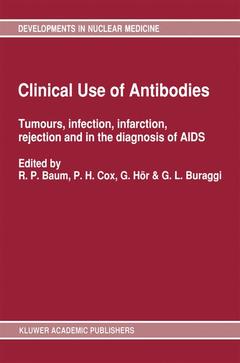Clinical Use of Antibodies, Softcover reprint of the original 1st ed. 1991 Tumours, infection, infarction, rejection and in the diagnosis of AIDS Developments in Nuclear Medicine Series, Vol. 19
Langue : Anglais
Coordonnateurs : Baum Richard P., Cox P.H., Hör Gustav, Buraggi Gian Luigi

It was at Frankfurt/Mainin 1899 that Paul Ehrlich first expounded his famous "site-chain theory" -which described the basic immunological principal of antibody-antigen interactio- on the occasion of the opening of the Institute for Experimental Therapeutics (which was later named after him). Nearly 100 years have passed since, and in retrospect it can be said that the "Ehrlich Era" (first steps in immunology "Magic Bullet" concept) and the "Behring Era" (detection of antibodies and serum therapy) formed the essential basis in the development of immunology. Niels K. Jerne, the former director of the Paul Ehrlich Institute in Frankfurt/Main received, together with Georges Kohler and Cesar Milstein, the Nobel Prize in Medicine 1984. These late successors of Ehrlich and Behring first described the hybridoma technology (in 1975) which enabled one of the most important and revolutionary technological innovations in the field of immunology -the production of monoclonal antibodies. It happens that, the time of the publication of this book, just a decade has passed since the first use of radiolabelled monoclonal antibodies in man (by the Lausanne Group). Over these 10 years a tremendous progress has taken place in the field of immunoscintigraphy:A large panel of highly specific monoclonal antibodies against tumour-associated antigens as well as normal cell compounds have been developed. Enormous progress has been made in the field of radiolabelling -from iodine-131 to technetium-99mor even positron-emittingradionuclides, e. g. iodine-124.
1. Advances in cancer imaging and therapy with radiolabelled antibodies.- 2. Evaluation of the diagnostic utility of immunoscintigraphy in oncology.- 3. The quality control and clinical testing of radiolabelled antibodies.- 4. Clinical utility of radiolabelled monoclonal antibodies in the management of gastrointestinal cancer.- 5. Use of 123-I radiolabelled F(AB’)2 fragments of anti-CEA monoclonal antibody for the detection of primary and metastatic gastrointestinal carcinomas.- 6. Bispecific monoclonal antibodies for two phase radioimmunotherapy.- 7. Antimyosin antibody imaging in myocardial infarction.- 8. Antimyosin based radioimmunodetection of myocarditis cardiomyopathy and cardiac transplant rejection.- 9. Recent advances in the use of radiolabelled monoclonal antibodies in the management of ovarian cancer.- 10. Monoclonal antibodies for cell labelling with particular reference to thrombus imaging.- 11. The role of nuclear medicine in the evaluation of the patient with acquired immune deficiency syndrome (AIDS).- 12. Detection of inflammation/infection using radiolabelled anti-granulocyte antibodies: possibilities and limitations.- 13. A new marker for the detection of adenocardinomas by radioimmunoscintigraphy.- 14. New developments in the diagnosis of AIDS and strategies for therapy.
Date de parution : 11-2012
Ouvrage de 185 p.
15.5x23.5 cm
Thèmes de Clinical Use of Antibodies :
Mots-clés :
© 2024 LAVOISIER S.A.S.



